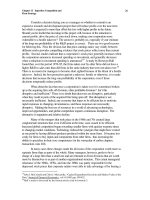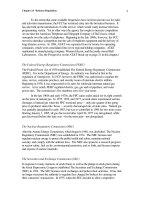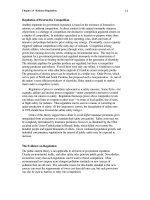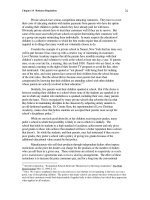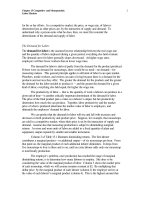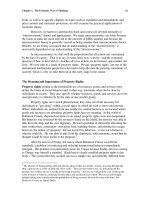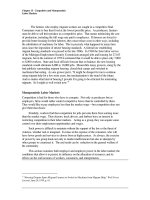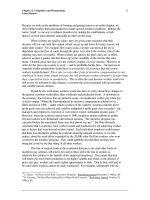Microeconomics for MBAs 48
Bạn đang xem bản rút gọn của tài liệu. Xem và tải ngay bản đầy đủ của tài liệu tại đây (43.05 KB, 10 trang )
Chapter 14 Business Regulation
14
Regulation of Destructive Competition
Another argument for government regulation is based on the existence of destructive,
ruinous, or cutthroat competition. In direct contrast to the natural monopoly situation,
where there is a shortage of competition, the destructive competition argument centers on
a surplus of competition. In industries specialized as to location or purpose where there
are high sunk costs in assets coupled with low operating costs, short-run bouts of
intensive and perhaps destructive price cutting may emerge. Presumably, excess capacity
triggered cutthroat competition in the early days of railroads. Competition among
electric utilities, who must transmit power through wires, could mean several sets of
power lines running down city streets, creating an environmental mess. This may be an
argument for a government protected and regulated monopoly on the transmission of
electricity, but it has no bearing on the need for regulation of the generation of electricity.
The interstate pipelines for gasoline products are regulated, but there is competition
among producers and refiners. Even if there were only one refiner, it would have to base
its pricing decisions on what other firms might do if it tried to extract monopoly profits.
The generation of electric power can be organized in a similar way. Duke Power, which
serves parts of North and South Carolina, has proposed such a reorganization. As one of
the nation’s most efficient producers of electricity, Duke stands to expand its market
share under a competitive system.
Regulation of prices is sometimes advocated as a safety measure. Some firms—for
example, airlines and nuclear power companies—under competitive pressure to control
costs may cut corners on safety. Regulation that keeps prices above competitive levels
can induce such firms to compete in other ways—in terms of food quality, size of seats,
or flight safety, for instance. Thus regulation can be seen as a means of correcting an
under-production of safety. (If this argument is correct, the deregulation of airline rates
in 1978 should have lowered the airline safety ratings.)
Critics of this theory suggest that a desire to avoid higher insurance premiums gives
unregulated firms an incentive to maintain their safety precautions. Safety costs may not
be completely internalized by insurance premiums, however, as illustrated by the 1984
accident at the Union Carbide plant in Bhopal, India, which killed over twenty-five
hundred people and injured thousands of others. Given continued population growth and
industrial concentration, regulation in the interest of public safety may be expected to
increase.
The Evidence on Regulation
The public interest theory is not applicable to all forms of government regulation.
Clearly environmental, traffic, and other safety rules promote public goals. Nevertheless,
economists worry that such regulations can be used to thwart competition. Most
environmental laws impose more stringent pollution standards on new sources of
pollution than on old ones. The ostensible reason for this double standard is that new
sources can meet the requirements at lower cost than old ones can, but such provisions
can also be used as barriers to entry into competition.
Chapter 14 Business Regulation
15
Research has raised especially serious doubt about the usefulness to the public of
economic regulation—regulation designed to restrict entry, pricing, and production
decisions in specific industries like trucking, airline, bus, stockbrokerage, taxi, cable, and
shipping services that appear to be competitive or contestable. In such industries, which
were heavily regulated in the past, neither the prices charged nor the difficulty of entry
can be justified on the grounds of efficiency. Much research, for example, suggests that
the regulation of electric power companies has tended to prop up electric rates and to
favor industrial and commercial users over residential users
6
Even in areas such as legal
services and drugs, where the need for regulation has seldom been challenged, its value to
the consumer is now being questioned.
Does regulation affect the competitive performance of an industry? The evidence is
mixed, and open to differing interpretations. Many health, environmental, and safety
regulations have clearly imposed substantial costs on businesses, consumers, and
workers. Both the profits and the competitiveness of U.S. steel firms and the wages of
steelworkers appear to have been seriously damaged by environmental legislation, for
instance.
In the late 1960s and 1970s, regulation may have depressed the returns earned by
electric utilities. Regulated industries have always had to wait for an upward adjustment
of rates after a rise in costs. Apparently the unusually high rates of inflation during that
period increased the strain on regulated industries. The story was different in the airline
industry, however. As one researcher wrote, “Paradoxically the [Civil Aeronautics
Board’s policies, on the whole, have probably had little effect on the rate of profit earned
by the industry; but, without the Civil Aeronautic Act and the Board, these profits would
have resulted from quite a different sort of operation.”
7
It was such arguments that led to
the deregulation of the airline industry in the late 1970s. Other scholars have complained
that FCC restrictions on entry into the broadcasting industry have enabled established
broadcasting firms to make substantial profits.
In the trucking industry, regulation had particularly poor results. Until the industry
was partially deregulated in the 1970s, the ICC turned down hundreds of applications a
year to enter the trucking business or extend existing service. In fact, from the late 1930s
through the 1960s, the number of licensed carriers actually decreased because of
regulation by the ICC. Regulations designed to ensure a “stable trucking industry”
frequently took trucks miles out of their way, increasing the cost of hauling cargo and the
rates charged. After taking a load to one destination, carriers were forbidden to pick up
cargo for the return trip.
The railroads had an entire century of regulation-induced problems. The results
since deregulation in 1980 have been staggering. Prices have fallen, service has
improved, profits have increased, and federal subsidies have fallen almost 90 percent.
6
For reviews of empirical studies and conceptual arguments, see Paul W. MacAvoy, ed., The Crisis of the
Regulatory Commissions: An Introduction to a Current Issue of Public Policy (New York: W.W. Norton,
1970); James Miller III and Bruce Yandle, eds., Benefit/Cost Analysis of Social Regulation (Washington,
D.C.: American Enterprise Institute, 1979); and George C. Eads and Michael Fix, eds., The Reagan
Regulatory Strategy: An Assessment (Washington, D.C.: Urban Institute, 1984)
7
Richard W. Caves, “Performance, Structure, and the Goals of Civil Aeronautics Board Regulation,” in
The Crisis of the Regulatory Commissions, p. 134.
Chapter 14 Business Regulation
16
Additional gains will be more difficult as there are still many regulations in railroads,
especially in labor-management relations.
Overall, the weight of the evidence is against much economic regulation. It is true
regulatory agencies have sometimes denied rate increases and required firms—railroads
and airlines, for example—to maintain services they would otherwise have eliminated.
Many economists, however, question whether regulatory agencies as a group have been
pursuing the public interest in any systematic way.
The Economic or Private Theory of Regulation
Why has regulation so often had little (if any) effect in reducing the profitability of
regulated industries? Perhaps regulators have been inept at carrying out their
responsibilities—or regulation may be too difficult a task for any one agency to handle
properly. Regulated firms have an incentive to deceive their regulators by fudging their
books to inflate their costs. As we have seen, gathering accurate information on a
company’s true costs and profits can be prohibitively expensive. Even with accurate
accounting, there is an incentive to “gold plate” costs, as firms operate on a cost-plus
basis. If demand is inelastic, these inflated costs can be passed on successfully to
consumers. Moreover, regulation focuses on static efficiency and provides inadequate
incentives for dynamic efficiency. A cost-saving innovation could lead to a cut in the
utility’s price.
A second explanation might be that while regulators are concentrating on prices and
barriers to entry, firms may maintain profits by reducing the quality (and therefore the
cost) of their products and services.
The intent of regulation may also be circumvented in another, more subtle way.
Regulators sometimes determine prices on the basis of a so-called fair rate of return or
profitability on capital investment. Such a standard encourages firms, particularly
utilities, to substitute plant and equipment for other resources, such as labor, which do not
count as investment. For example, suppose a regulatory agency establishes that 10
percent is a fair return on investment. Firms will then be allowed to make profits equal to
10 percent of the value of their plant and equipment. Suppose further that the same
amount of additional electricity can be generated by spending $1 million on plant and
equipment or $1 million on labor. If a firm invests in plant and equipment, it can ask the
regulatory agency to raise its rates to allow for an additional $100,000 in profit (10
percent of $1 million). If it uses labor instead, it will have no increase in investment on
which to base a request for a price increase. By making production capital-intensive,
firms can circumvent the intent of regulation.
Thirdly, although regulation may be instituted with good intentions, regulators may
become the pawns of regulated firms. If regulatory agencies are staffed by men and
women who made their careers in the industries they are regulating, regulated firms may
gain undue influence over regulatory policy.
Finally, the biggest shortcoming of regulation is that it often has been applied to
competitive or contestable markets. Even if originally the market was a natural
monopoly, it may have moved through a cycle where it is now competitive and thus no
Chapter 14 Business Regulation
17
longer in need of regulation. Many regulated industries are not now (and perhaps never
have been) natural monopolies (e.g., motor trucking). In addition, some natural
monopolies (e.g., main-frame computers) may have escaped the intricate web of
regulation.
For all these reasons, many economists have begun to discard or at least downplay
the public interest theory of regulation in favor of an industry-centered view. Instead of
seeing regulation as something thrust on firms, they have begun to view it as a service
frequently sought by those who are regulated.
8
It is important to recognize that the public
and private interest theories are not necessarily diametrically opposed. The seeking of
private interest is consistent with certain types of efficient regulation, and the public
interest theory recognizes that mistakes and culpable regulators make regulation
inefficient at times.
Probably the biggest impetus to the economic theory of regulation was the
inadequacy of the public interest theory in answering two essential questions: Why were
inherently competitive or contestable industries such as airlines, taxicab, and trucking
regulated if the purpose was to protect against natural monopolistic pricing? Why do
unregulated firms persistently desire to enter regulated industries if regulators push prices
and profits to the bare-bones competitive level?
The Supply and Demand for Regulation
In the new expenditures theory of regulation, government is seen as a supplier of
regulatory services to industry. Such services can include price fixing, restrictions on
market entry, subsidies, and even suppression of substitute goods (or promotion of
complementary goods). For example, regulation enables producers to suppress the sale
of margarine in Wisconsin. Through the FCC, commercial television stations have been
able to delay the introduction of cable TV.
These regulatory services are not free; they are offered to industries willing to pay
for them. In the political world, the price of regulatory services may be campaign
contributions or lucrative consulting jobs, or votes and volunteer work for political
campaigns. Regulators and politicians allocate the benefits among all the various private
interest groups so as to equate political support and opposition at the margin.
Firms demand regulation for their own private-interest, rent-seeking reasons. As
we have seen, forming a cartel in a free market can be difficult both because new firms
may enter the market and because colluders tend to cheat on cartel agreements. The cost
of reaching and enforcing a collusive agreement can be so high that government
regulation is attractive in comparison.
The view that certain forms of regulation emerge from the interaction of
government suppliers and industry demanders seems to square with much historical
evidence. As Richard Posner has observed,
8
See George J. Stigler, “The Theory of Economic Regulation,” in The Citizen and the State (Chicago:
University of Chicago Press, 1975), and Stephen Breyer, Regulation and Its Reform (Cambridge, Mass.:
Harvard University Press, 1982).
Chapter 14 Business Regulation
18
The railroads supported the enactment of the first Interstate Commerce Act,
which was designed to prevent railroads from price discrimination because
discrimination was undermining the railroad’s cartels. American Telephone
and Telegraph pressed for state regulation of telephone service because it
wanted to end competition among telephone companies. Truckers and
airlines supported extension of common carrier regulation to their industries
because they considered unregulated competition excessive.
9
Barbers, beauticians, lawyers, and other specialists have all sought government licensing,
which is a form of regulation. Farmers have backed moves to regulate the supply of the
commodities they produce. Whenever deregulation is proposed, the industry in question
almost always opposes the proposal.
Regulation as a Public Good for Industry
To the extent that regulation benefits all regulated firms, whether or not they contributed
to the cost of procuring it, industries may consider regulation a public good. This creates
a free-rider problem, which occurs when people can enjoy the benefits of a scarce good
or service without paying directly for it by pretending not to want that good or service.
Some firms will try to free ride on others’ efforts to secure regulation. If all firms free
ride, however, the collective benefits of regulation will be lost.
The free-rider phenomenon is particularly noticeable in large groups, whose cost
of organizing for collective action can be substantial. Someone must bear the initial cost
of organization. Yet because the benefits of organization are spread more or less evenly
over the group, the party that initiates the organization may incur costs greater than the
benefits it receives. Thus collective action may not be taken. Free riding may explain
why some large groups, such as secretaries, have not yet secured government protection.
Everyone may be waiting for everyone else to act. Small groups may have much greater
success because of their proportionally smaller organizational costs and larger individual
benefits. Perhaps it was because only a few railroad companies existed in the 1880s that
they were able to lobby successfully for the formation of the ICC.
There are some exceptions to this rule. Several reasonably large groups,
including truckers and farmers, have secured a high degree of government regulation,
while many highly concentrated groups, such as the electrical appliance industry, have
not. In highly concentrated industries. It may be less costly to develop private cartels
than to organize to secure government regulation. In industries composed of many firms,
on the other had, any one firm’s cost of securing regulation may be smaller than the costs
of a cartel. Large groups also control more sizable voting blocks than small groups.
They may have the advantage of established trade associations, whose help can be
enlisted in pushing for protective legislation.
10
9
Richard A. Posner, “Theories of Economic Regulation,” Bell Journal of Economics and Management
Science (Autumn 1974), p. 337.
10
See Mancur Olson, The Logic of Collective Action (Cambridge, Mass.: Harvard University Press, 1971)
Chs. 1 and 2.
